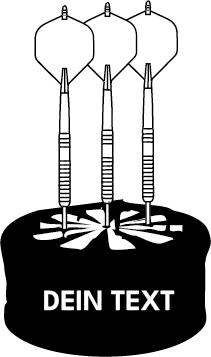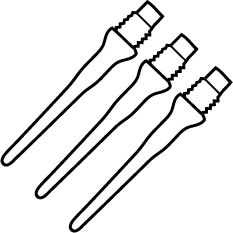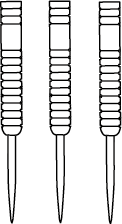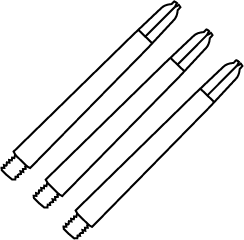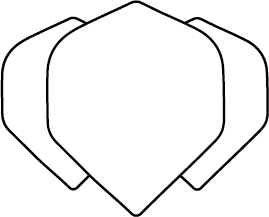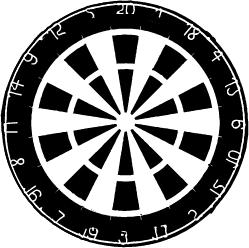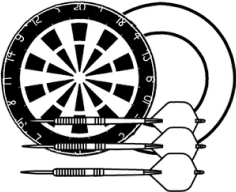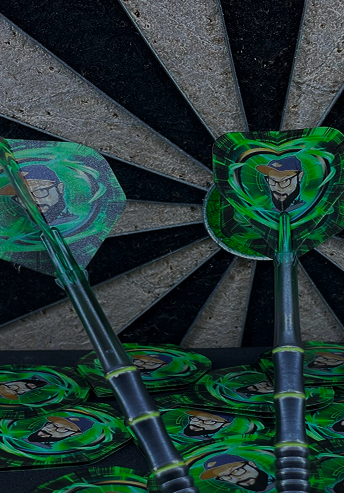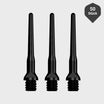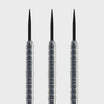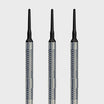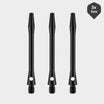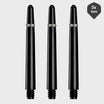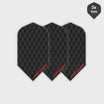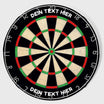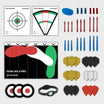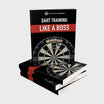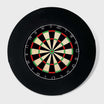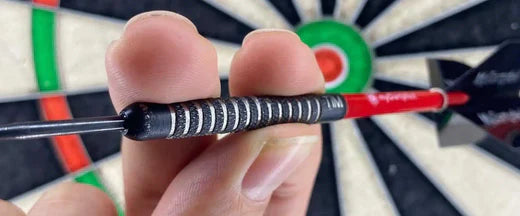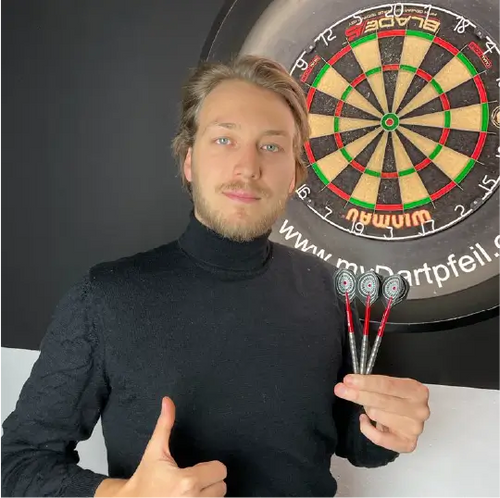In this blog post, we'd like to go into the exact rules of steel tip darts in more detail. At the end, we'll also briefly explain the rules of soft tip darts. However, we'll be posting a separate blog post on this. There are crucial differences between steel tip darts and soft tip darts, which require two separate posts. With this guide, you should be well prepared for your first steel tip dart game. Regulations and important rules of conduct should not be underestimated, especially when dealing with your opponent.
Basic steel dart rules
First, we'd like to discuss the basic rules of steel darts . Let's start from the very beginning. The following standard rules have always been in place for steel darts. The bull's-eye , or center of the steel dartboard , is hung at a height of 173 centimeters. It's important to note that this is the center and must be fixed at this height. Another of the many steel dart rules states that the throwing line, or oche , must be exactly 237 centimeters from the dartboard.
A good way to check whether you're adhering to these steel dart dimensions is to measure the diagonal distance from the throwing line to the center of the dartboard. If the diagonal distance is exactly 293 centimeters, then the height of the board and the distance to the board are correct. You should definitely check this, because in competition, it can have disastrous consequences if you stand 2 centimeters closer or further away during practice, for example.
Good to know: As a player in a regular competition, you have the right to have your steel darts checked before starting at any time. It's not uncommon for players to report that they feel significantly closer or further away from the board in unfamiliar venues. However, this isn't necessarily the case. To be on the safe side, a check is certainly not a bad idea.

Important information about darts in steel darts
There are a few special features with steel darts that make them different from soft darts. This starts with the tips of the steel darts. You can generally throw on a steel dartboard with either steel or plastic tips. This may surprise some readers, but it's not uncommon, as plastic tips also hold in a steel dartboard. However, depending on the board's rigidity, you may have to throw the darts with these tips a bit harder, which can take a lot of effort over time. Nevertheless, it's technically possible and not prohibited.
Normally, darts with steel tips are used. After all, it's not for nothing that the sport is called steel darts. And of course, there's another crucial factor that contributes to the use of darts that stay securely in the board. The reason is that in steel darts, only those darts that stay in the board and are pulled out by the thrower count. So, if you throw three darts into the T20 and one of your darts bounces off or falls out, you'll only end up with 120 points – incredibly frustrating!
Therefore, it is important to sharpen your steel darts regularly to ensure that they stay stuck in the board.
Weight and length of the darts
As with soft tip darts, steel tip darts also have a weight limit. In this case, it's a whopping 50 grams. Logically, no player actually plays with such "spears," as they're difficult to control and far too heavy. By comparison, Ryan Searle plays by far the heaviest darts in the PDC , weighing 32 grams each. So, the 50-gram weight is really just a basic limitation, just to have a rule at all. That leaves the length of the darts. There are clear restrictions here, too. The maximum length from tip to flight is 30.5 centimeters. Here, too, no player comes anywhere close to this length.

The development of the sport and the demarcation of e-darts
Overall, the history of the sport of steel darts is still relatively young. It must be clearly stated that, especially in Germany, soft tip darts are still the most popular sport and are played by significantly more athletes. However, this has changed dramatically in recent years. For around 15 years, the PDC World Championship , which is famously played with steel tip darts, has been broadcast on television. This has also led to a small darts boom in Germany. While soft tip darts players were somewhat surprised by this, more and more new players have found their way to steel tip darts. Even if soft tip darts are clearly ahead at the moment, it must be noted that steel tip darts will catch up significantly in the long term.
Overall, the history of the sport of steel darts is still relatively young. It must be clearly stated that, especially in Germany, soft tip darts are still the most popular sport and are played by significantly more athletes. However, this has changed dramatically in recent years. For around 15 years, the PDC World Championship , which is famously played with steel tip darts, has been broadcast on television. This has also led to a small darts boom in Germany. While soft tip darts players were somewhat surprised by this, more and more new players have found their way to steel tip darts. Even if soft tip darts are clearly ahead at the moment, it must be noted that steel tip darts will catch up significantly in the long term.
In addition, the sport clearly tries to differentiate itself from the "bar sport" of soft darts and appear more serious. Soft dart players often laugh about this, which is why disagreements often arise when discussing the two sports.
The behavior of darts players during the competition
One final point is actually almost more important than the established steel dart rules. It concerns the behavior of the dart players on stage, or at the oche. Steel darts deliberately wanted to differentiate themselves from soft darts, which is why alcohol was banned on stage. A dress code was also introduced to ensure that players were well-dressed for their sport. This is precisely where some rules that are simply accepted in darts come into play.
The so-called handshake after every game is very important. It's simply appropriate to wish your opponent good darts before the game and shake hands with them afterward to congratulate them on a good game. But that's not all. It's equally inappropriate to interrupt your opponent's concentration while throwing. This primarily refers to noises or similar. A noticeable cough or similar is often used.

High-fiving as a gesture of respect
Last but not least, there's the high-five for good shots or high checkouts. Here, too, it's considered proper to extend your fist to your opponent for a high-five – simply as a gesture of respect. You'll notice: If you don't heed these unwritten rules in a competition, you'll quickly receive some dirty looks!
Ready to take your skills to the next level? Discover our exclusive secrets and proven methods to optimize your game:
- Learn more about Dart mental training and important dart mental tips to improve your dart game. Read more about mental training for darts now.
- Here you'll learn more about an effective dart training plan for beginners. We'll focus on scoring and doubles training.
Sofern nicht anders angegeben, unterliegt das im Beitrag gezeigte Bildmaterial mit Bezug zu Dartspielern und verwandten Themen dem Copyright der Professional Darts Corporation (© PDC).

